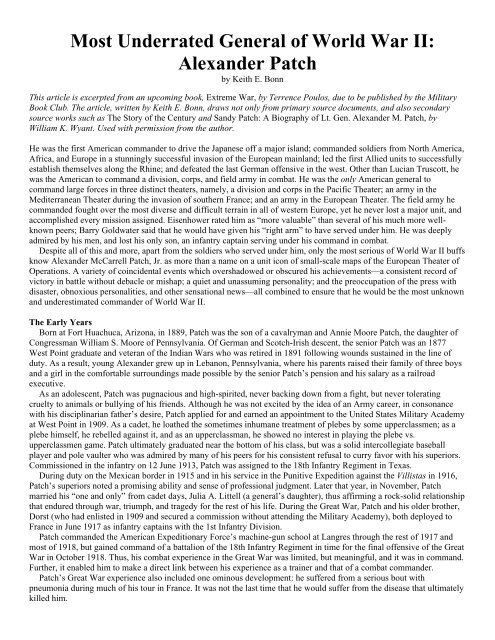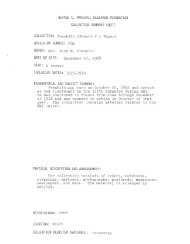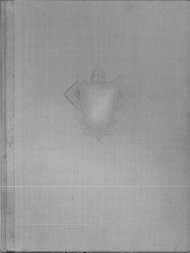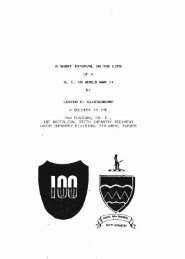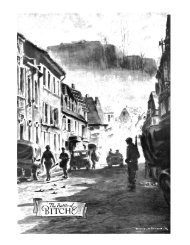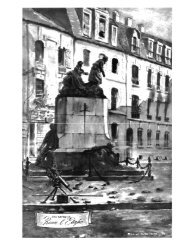Most Underrated General of World War II - The George C. Marshall ...
Most Underrated General of World War II - The George C. Marshall ...
Most Underrated General of World War II - The George C. Marshall ...
You also want an ePaper? Increase the reach of your titles
YUMPU automatically turns print PDFs into web optimized ePapers that Google loves.
<strong>Most</strong> <strong>Underrated</strong> <strong>General</strong> <strong>of</strong> <strong>World</strong> <strong>War</strong> <strong>II</strong>:<br />
Alexander Patch<br />
by Keith E. Bonn<br />
This article is excerpted from an upcoming book, Extreme <strong>War</strong>, by Terrence Poulos, due to be published by the Military<br />
Book Club. <strong>The</strong> article, written by Keith E. Bonn, draws not only from primary source documents, and also secondary<br />
source works such as <strong>The</strong> Story <strong>of</strong> the Century and Sandy Patch: A Biography <strong>of</strong> Lt. Gen. Alexander M. Patch, by<br />
William K. Wyant. Used with permission from the author.<br />
He was the first American commander to drive the Japanese <strong>of</strong>f a major island; commanded soldiers from North America,<br />
Africa, and Europe in a stunningly successful invasion <strong>of</strong> the European mainland; led the first Allied units to successfully<br />
establish themselves along the Rhine; and defeated the last German <strong>of</strong>fensive in the west. Other than Lucian Truscott, he<br />
was the American to command a division, corps, and field army in combat. He was the only American general to<br />
command large forces in three distinct theaters, namely, a division and corps in the Pacific <strong>The</strong>ater; an army in the<br />
Mediterranean <strong>The</strong>ater during the invasion <strong>of</strong> southern France; and an army in the European <strong>The</strong>ater. <strong>The</strong> field army he<br />
commanded fought over the most diverse and difficult terrain in all <strong>of</strong> western Europe, yet he never lost a major unit, and<br />
accomplished every mission assigned. Eisenhower rated him as “more valuable” than several <strong>of</strong> his much more wellknown<br />
peers; Barry Goldwater said that he would have given his “right arm” to have served under him. He was deeply<br />
admired by his men, and lost his only son, an infantry captain serving under his command in combat.<br />
Despite all <strong>of</strong> this and more, apart from the soldiers who served under him, only the most serious <strong>of</strong> <strong>World</strong> <strong>War</strong> <strong>II</strong> buffs<br />
know Alexander McCarrell Patch, Jr. as more than a name on a unit icon <strong>of</strong> small-scale maps <strong>of</strong> the European <strong>The</strong>ater <strong>of</strong><br />
Operations. A variety <strong>of</strong> coincidental events which overshadowed or obscured his achievements—a consistent record <strong>of</strong><br />
victory in battle without debacle or mishap; a quiet and unassuming personality; and the preoccupation <strong>of</strong> the press with<br />
disaster, obnoxious personalities, and other sensational news—all combined to ensure that he would be the most unknown<br />
and underestimated commander <strong>of</strong> <strong>World</strong> <strong>War</strong> <strong>II</strong>.<br />
<strong>The</strong> Early Years<br />
Born at Fort Huachuca, Arizona, in 1889, Patch was the son <strong>of</strong> a cavalryman and Annie Moore Patch, the daughter <strong>of</strong><br />
Congressman William S. Moore <strong>of</strong> Pennsylvania. Of German and Scotch-Irish descent, the senior Patch was an 1877<br />
West Point graduate and veteran <strong>of</strong> the Indian <strong>War</strong>s who was retired in 1891 following wounds sustained in the line <strong>of</strong><br />
duty. As a result, young Alexander grew up in Lebanon, Pennsylvania, where his parents raised their family <strong>of</strong> three boys<br />
and a girl in the comfortable surroundings made possible by the senior Patch’s pension and his salary as a railroad<br />
executive.<br />
As an adolescent, Patch was pugnacious and high-spirited, never backing down from a fight, but never tolerating<br />
cruelty to animals or bullying <strong>of</strong> his friends. Although he was not excited by the idea <strong>of</strong> an Army career, in consonance<br />
with his disciplinarian father’s desire, Patch applied for and earned an appointment to the United States Military Academy<br />
at West Point in 1909. As a cadet, he loathed the sometimes inhumane treatment <strong>of</strong> plebes by some upperclassmen; as a<br />
plebe himself, he rebelled against it, and as an upperclassman, he showed no interest in playing the plebe vs.<br />
upperclassmen game. Patch ultimately graduated near the bottom <strong>of</strong> his class, but was a solid intercollegiate baseball<br />
player and pole vaulter who was admired by many <strong>of</strong> his peers for his consistent refusal to curry favor with his superiors.<br />
Commissioned in the infantry on 12 June 1913, Patch was assigned to the 18th Infantry Regiment in Texas.<br />
During duty on the Mexican border in 1915 and in his service in the Punitive Expedition against the Villistas in 1916,<br />
Patch’s superiors noted a promising ability and sense <strong>of</strong> pr<strong>of</strong>essional judgment. Later that year, in November, Patch<br />
married his “one and only” from cadet days, Julia A. Littell (a general’s daughter), thus affirming a rock-solid relationship<br />
that endured through war, triumph, and tragedy for the rest <strong>of</strong> his life. During the Great <strong>War</strong>, Patch and his older brother,<br />
Dorst (who had enlisted in 1909 and secured a commission without attending the Military Academy), both deployed to<br />
France in June 1917 as infantry captains with the 1st Infantry Division.<br />
Patch commanded the American Expeditionary Force’s machine-gun school at Langres through the rest <strong>of</strong> 1917 and<br />
most <strong>of</strong> 1918, but gained command <strong>of</strong> a battalion <strong>of</strong> the 18th Infantry Regiment in time for the final <strong>of</strong>fensive <strong>of</strong> the Great<br />
<strong>War</strong> in October 1918. Thus, his combat experience in the Great <strong>War</strong> was limited, but meaningful, and it was in command.<br />
Further, it enabled him to make a direct link between his experience as a trainer and that <strong>of</strong> a combat commander.<br />
Patch’s Great <strong>War</strong> experience also included one ominous development: he suffered from a serious bout with<br />
pneumonia during much <strong>of</strong> his tour in France. It was not the last time that he would suffer from the disease that ultimately<br />
killed him.
In an army as small as the miniature US Army between the wars, (190,000 men in 1939), Patch managed to keep his<br />
hand in training combat troops as well as honing his skills as a coach and mentor <strong>of</strong> young men.<br />
Between the wars, Patch spent 11 years, parsed out over three separate tours, as Pr<strong>of</strong>essor <strong>of</strong> Military Science and<br />
Tactics at Staunton Military Academy, a private secondary school in western Virginia, near the Virginia Military Institute<br />
(VMI). Here, while Patch honed his skills as a trainer and groomer <strong>of</strong> young men, he met and befriended Withers A.<br />
Burress, the commandant at the VMI, who later commanded the 100th Infantry Division under Patch in Europe in WW<strong>II</strong>.<br />
One <strong>of</strong> his last assignments before the US entered WW<strong>II</strong> was as commander <strong>of</strong> the 47th Infantry Regiment <strong>of</strong> the 9th<br />
Infantry Division at Fort Bragg, North Carolina. This assignment was a particularly fortuitous one, as the 9th’s<br />
commanding general was Jacob Devers, a man who would later figure very prominently in Patch’s WW<strong>II</strong> service<br />
Patch in the Pacific<br />
Barely a month after the Japanese sneak attack at Pearl Harbor, Patch was promoted to major general and assigned to<br />
command Task Force 6814, a quickly tossed-together ad hoc assembly <strong>of</strong> roughly divisional size built around two<br />
National Guard infantry regiments. <strong>The</strong> task force was charged with the mission <strong>of</strong> defending the French colony <strong>of</strong> New<br />
Caledonia from what appeared to be imminent Japanese attack; with things going quite badly for the American Regular<br />
Army forces in the Philippines at the time, there was considerable question about the ability <strong>of</strong> US forces to defeat the<br />
Japanese on the ground. So Patch was literally the “man in the arena,” the champion personally selected by Army Chief <strong>of</strong><br />
Staff <strong>George</strong> C. <strong>Marshall</strong> to go to the southwest Pacific with whatever the Army could scrape together and stand between<br />
the rapidly-advancing Japanese and the frantically-preparing Australians.<br />
En route, Patch was again stricken with pneumonia, but overcame it again to arrive in New Caledonia in early March<br />
1942. Although this was literally his first acquaintance with his new command, he busily set about organizing and training<br />
them for the formidable task at hand: defending the 1,250-mile-long island.<br />
With New Caledonia secure, Patch’s next mission as commanding general <strong>of</strong> the Americal Division (this name was<br />
suggested by PFC David Fonseca, combining “American” with “New Caledonia”) was to relieve the 1st Marine Division<br />
and, on orders from Admiral Halsey, “eliminate all Japanese forces on Guadalcanal.” Landing in August 1942, Marine<br />
Major <strong>General</strong> Archie Vandegrift’s division struck the first American <strong>of</strong>fensive blow on the ground against the Japanese<br />
who, up until that time, had been seemingly invincible in their defeats <strong>of</strong> the Americans in the Philippines, the British at<br />
Singapore, and the Dutch in the East Indies. Locked in desperate fighting in the pesthole that was Guadalcanal, the<br />
Marines and their US Navy supporting elements tenaciously fought a see-saw action that held on to the crucial perimeter<br />
around the key airstrip at Henderson Field, but were unable to make decisive headway against constantly-reinforced,<br />
aggressive Japanese forces.<br />
On 9 December Patch and the Americal Division <strong>of</strong>ficially relieved Vandegrift and the 1st Marine Division. In early<br />
January, as the 25th Infantry Division and 2nd Marine Division completed their deployment to Guadalcanal, Patch was<br />
promoted to command <strong>of</strong> the newly-created XIV Corps, the headquarters which controlled them all.<br />
Patch launched the corps’ attack on 10 January 1943, and in almost exactly a month <strong>of</strong> vicious jungle fighting, XIV<br />
Corps methodically and effectively cleared the Japanese from Guadalcanal. It was an immensely important victory<br />
because it was pro<strong>of</strong> that American ground forces could not only stave <strong>of</strong>f defeat—as the 1st Marine Division had in the<br />
first four months <strong>of</strong> the Guadalcanal operation—but decisively clear the Japanese <strong>of</strong>f a large island.<br />
Typically, few people today associate Patch’s name with Guadalcanal. Marine Major <strong>General</strong> Archie Vandegrift, who<br />
was awarded the Medal <strong>of</strong> Honor and later went on to become the Commandant <strong>of</strong> the Marine Corps, is the general<br />
<strong>of</strong>ficer whose name is usually associated with this battle. Partially, this is undoubtedly due to the Marines’ legendary<br />
public relations talents, and partially, it is a function <strong>of</strong> timing. Public awareness <strong>of</strong> the exceptionally important and hardwon<br />
victory on Guadalcanal, skillfully engineered by Patch with many <strong>of</strong> the soldiers he personally trained, was largely<br />
lost in the hoopla surrounding his predecessor’s publicity and the other major, positive developments in the course <strong>of</strong> the<br />
war. Although it was all fine with the self-effacing, quietly-pr<strong>of</strong>essional Patch, it was far from the last time that this sort <strong>of</strong><br />
phenomenon would obscure his magnificent achievements.<br />
After Guadalcanal, <strong>Marshall</strong> recalled Patch to command IV Corps at Fort Lewis. <strong>Marshall</strong> had been apprised,<br />
accurately, that the campaigns in the southwest Pacific had severely degraded Patch’s health, and, remembering his nearrun<br />
bout with pneumonia en route to New Caledonia, the Chief <strong>of</strong> Staff brought him back to a more hospitable climate.<br />
During the period at Lewis, Patch built a staff, combining <strong>of</strong>ficers who had served with him in the southwest Pacific with<br />
many who had been already serving in IV Corps when Patch arrived. To a very great extent, this was the staff that Patch<br />
would take with him for the rest <strong>of</strong> the war, so they were a very cohesive and well-coordinated group indeed. Patton was<br />
not the only one to derive intense loyalty from his subordinate staffers.
Seventh Army in the ETO<br />
In March 1944, Patch assumed command <strong>of</strong> the Seventh Army, then only a headquarters in North Africa. <strong>The</strong> Seventh<br />
Army would have tactical control <strong>of</strong> all allied troops during the upcoming Operation ANVIL (later re-dubbed DRAGOON),<br />
the invasion <strong>of</strong> Southern France. Under the command <strong>of</strong> the North African <strong>The</strong>ater (which became designated as the<br />
Mediterranean <strong>The</strong>ater in November) and using three veteran US divisions <strong>of</strong> VI Corps under the experienced and reliable<br />
Lucian Truscott (3rd, 36th, and 45th Infantry Divisions, all veterans <strong>of</strong> extensive mountain fighting in Italy) to make his<br />
main attack, Patch also had other important assets at his disposal. A provisional airborne division—with American and<br />
British parachute and glider troops—would land well inland <strong>of</strong> the beaches to prevent rapid reinforcement <strong>of</strong> the<br />
defenders, cut <strong>of</strong>f German withdrawals, and interfere with the Germans’ command, control, and communications systems.<br />
Commencing on D+1, the equivalent <strong>of</strong> two French corps would follow the American assault troops; these consisted <strong>of</strong><br />
mostly soldiers from French colonies in northern and western Africa, led by white French <strong>of</strong>ficers. <strong>The</strong> political pressure<br />
on Patch to get these French troops into combat as quickly as possible had no parallel in the Normandy operation.<br />
Thus, Patch would command soldiers from three continents in an invasion which, if not as complex as the Overlord<br />
landings, were nevertheless substantial and elaborate, and which posed some very different challenges from those<br />
encountered in Normandy. <strong>The</strong> choke points for the landing area were much further inland than the ones for the Overlord<br />
beaches, so the airborne landings would have to be much deeper (ten miles). This vastly increased the risk to both the<br />
airborne and amphibious forces. Also, the details <strong>of</strong> the airborne operation were planned in just five weeks and executed<br />
by an ad hoc unit whose subordinate formations consisted <strong>of</strong> one US parachute infantry regiment, three separate US<br />
parachute infantry battalions, a British parachute brigade, and numerous separate glider-borne units—some <strong>of</strong> which, such<br />
as the Anti-Tank Company <strong>of</strong> the Nisei 442nd Infantry Regiment and several 4.2" heavy mortar outfits, had never even<br />
seen a glider before.<br />
Apart from the amphibious and airborne landings <strong>of</strong> VI Corps and the Provisional Airborne Division, there were pre-Hhour<br />
assaults by American and Canadian commandos (the famed 1st Special Service Force, or “Devil’s Brigade”), French<br />
Commandos, and French naval infantry. Patch’s plan incorporated massive deception operations intended to mask the true<br />
location and nature <strong>of</strong> the main landings. A huge signals deception effort seemed to indicate a shift <strong>of</strong> forces in north<br />
Africa, and a variety <strong>of</strong> naval diversionary efforts suggested landings at locations as diverse as Genoa, Italy, Nice, and<br />
Marseilles. All <strong>of</strong> this was planned and executed by Patch’s headquarters, which was only a fraction <strong>of</strong> the size <strong>of</strong><br />
Eisenhower’s in England, and had nothing like the all-out priority <strong>of</strong> Overlord from the Combined Chiefs.<br />
Executed commencing 15 August 1944, Dragoon and the Seventh Army’s subsequent pursuit <strong>of</strong> German forces up the<br />
Rhône Valley were very successful. As late as 10 August, German intelligence was convinced that no landings would take<br />
place on the Mediterranean coast at all, and as late as 12 August—the day the invasion force put to sea—German<br />
intelligence could not predict whether the landings would be in France or Italy. Even on D-day—as the first Allied<br />
paratroopers hit the French earth and the French commandos began landing on the islands just <strong>of</strong>f the invasion beaches—<br />
the commander and staff <strong>of</strong> the 19th Army could not determine the location <strong>of</strong> Patch’s main effort.<br />
As a result, unlike the Normandy landings, which failed to result in the capture <strong>of</strong> a single usable major port, the<br />
southern France invasion yielded two major deep-water ports—Marseilles and Toulon—which were put into use by early<br />
September. <strong>The</strong> especial rapidity <strong>of</strong> the American assault landings and the nimble arrival <strong>of</strong> the equivalent <strong>of</strong> two French<br />
corps assured the rapid expansion <strong>of</strong> the beachhead and the destruction <strong>of</strong> two German divisions, the 242nd and 244th<br />
Infantry. <strong>The</strong> rest <strong>of</strong> Army Group G was severely disorganized and quickly put to flight. Ultimately, over 88,000 Germans<br />
from Army Group G were captured by the Seventh Army during its pursuit <strong>of</strong> German forces up the Rhône River valley.<br />
This astounding total is all the more amazing when contrasted with the total German prisoner haul from the much more<br />
famous Falaise encirclement, which netted—depending on how one figures it—only 50,000–70,000 German prisoners.<br />
Patch’s Seventh Army’s accomplishments are spectacular for more reasons than these. Far less air support was<br />
available, for example, than had been allotted to the Overlord efforts. Less than 10 percent <strong>of</strong> the 3,500 tactical aircraft<br />
that had been allotted to the Normandy landings were tasked by the combined Mediterranean Allied Air Forces for<br />
support <strong>of</strong> the Dragoon landings. <strong>The</strong> mechanized and armored forces available to Patch were a mere shadow <strong>of</strong> those<br />
made available to Bradley. Aside from the very temporary use <strong>of</strong> one combat command (brigade) <strong>of</strong> the French 1st<br />
Armored Division, Patch could only count on three US separate tank battalions, three US separate tank destroyer<br />
battalions, and the VI Corps’ mechanized cavalry reconnaissance squadron. <strong>The</strong> next time additional armored forces<br />
would be made available to the Seventh Army would not be until XV Corps was allotted from Third Army in late<br />
September.<br />
Nevertheless, Patch made optimal use <strong>of</strong> what he had. Attaching most <strong>of</strong> his armor to his three infantry divisions to<br />
enable combined arms operations for pursuit <strong>of</strong> German forces withdrawing northward up the Rhône Valley, Patch<br />
created Task Force (TF) Butler, commanded by the VI Corps Assistant Commanding <strong>General</strong>. Built around the<br />
117thCavalry Squadron, before the end <strong>of</strong> August, in conjunction with the X<strong>II</strong> Tactical Air Command and elements <strong>of</strong> the
36th Infantry Division, this small ad hoc task force did much to cut <strong>of</strong>f and bottle up German 19th Army units attempting<br />
to withdraw to the Vosges Mountains and Belfort Gap, their ultimate destination. German units such as the 198th and<br />
338th Infantry Divisions completed the withdrawal from southern France with their combat strength depleted by about 80<br />
percent, while American casualties amounted to less than 5 percent <strong>of</strong> the forces committed.<br />
<strong>The</strong> Seventh Army’s rapid progress northward forced all <strong>of</strong> Army Group G to withdraw to northeastern France, and<br />
resulted in the liberation <strong>of</strong> fully 65 percent <strong>of</strong> all French territory. As Eisenhower said after the war, “there was no<br />
development <strong>of</strong> that period [summer 1944] which added more decisively to our advantage or aided us more in<br />
accomplishing the final and complete defeat <strong>of</strong> German forces than did this attack coming up the Rhône valley.”<br />
Typically, Patch himself was very low key about all <strong>of</strong> this, and remained focused on the operations at hand. When his<br />
photo appeared on the cover <strong>of</strong> the 25 August 1944 Time magazine, the Seventh Army Public Information Officer rushed<br />
in to his <strong>of</strong>fice with a copy, only to have Patch ignore the story inside altogether. According to the secretary <strong>of</strong> his general<br />
staff during the war, Patch genuinely hated the limelight and avoided publicity for himself.<br />
Apart from the Time article, however, Patch’s accomplishments went virtually unnoticed by the press, and so by the<br />
rest <strong>of</strong> the world. In the same week that his Seventh Army was routing German forces and beginning the end <strong>of</strong> the<br />
occupation <strong>of</strong> two-thirds <strong>of</strong> France, the fierce fighting around Falaise and Argentan was nearing a climax. <strong>The</strong> so-called<br />
“GI’s <strong>General</strong>,” Omar Bradley, commanded First Army in this important battle, and <strong>George</strong> Patton commanded the<br />
recently created Third. Patton was always avidly watched by the press.<br />
Ten days after the Dragoon landings, as Toulon and Marseilles were on the verge <strong>of</strong> falling to the Seventh Army and<br />
the remainder <strong>of</strong> Army Group G was departing from southern France, the German commandant <strong>of</strong> Paris disobeyed his<br />
orders and let Paris be liberated by Jacques Leclerc and his soon-to-be-famous French 2nd Armored Division. On the<br />
same day, Germany lost an important ally as Romania switched sides, and declared war on Germany.<br />
Although Patch’s Seventh Army’s accomplishment was, indeed, decisive for the liberation <strong>of</strong> France, once again, other<br />
momentous events, occurring simultaneously, grabbed the headlines and stole the thunder from Patch and his consistent -<br />
victories.<br />
In mid-September, the two French corps under Patch’s command were stripped away to form the new First French<br />
Army, and along with Seventh Army. This came under command <strong>of</strong> the newly-formed Sixth Army Group, commanded by<br />
Jacob Devers. At about the same time, the Sixth Army Group came under command <strong>of</strong> Supreme Headquarters, Allied<br />
Expeditionary Forces, and was thus no longer controlled by the North African <strong>The</strong>ater <strong>of</strong> Operations. Left with only a<br />
single corps under his command, Patch nevertheless pushed forward, pressing back German forces into the western slopes<br />
<strong>of</strong> the High Vosges mountain range. By steadily forcing the Germans back from the Moselle River, he deprived them <strong>of</strong><br />
choice defensive terrain, and compelled them to occupy their main defensive lines in the Vosges before the massive<br />
German engineer and labor forces committed there could complete them. Even as Operation MARKET-GARDEN—the<br />
airborne thrust through the Netherlands toward the Rhine—was grinding to a dismal conclusion and the British 1st<br />
Airborne Division was being reduced to combat ineffectiveness, Seventh Army was gradually, consistently, pushing ever<br />
forward.<br />
In late September, XV Corps was transferred to Patch’s control, and the Seventh Army’s combat power doubled. Upon<br />
losing the corps, <strong>George</strong> Patton, ever the prima donna and supremely childish egotist, delivered these sour grapes to his<br />
Army Group commander, Bradley, “I hope [Devers’s] plan goes sour.” Eisenhower, who barely tolerated Patton but<br />
despised Devers, expected little or no benefit from gaining control (and responsibility) for his army group, beyond support<br />
for Bradley’s Twelfth Army Group efforts.<br />
Aside from Eisenhower’s well-documented personal antipathy for Devers, however, there was a certain amount <strong>of</strong><br />
logic to Eisenhower’s attitude. <strong>The</strong> Seventh Army’s logistical support originated 400 miles to the south, in Marseilles. A<br />
single rail line and a single highway, National Route 7, was the tenuous link to whatever supplies the Seventh Army could<br />
get from those far away docks . . . which were still under control <strong>of</strong> the North African <strong>The</strong>ater <strong>of</strong> Operations, and<br />
therefore competing with the needs <strong>of</strong> the more established Fifth Army in Italy. (This situation was not resolved until<br />
November, when the logistical support <strong>of</strong> the Sixth Army Group through Marseilles and Toulon became an ETO<br />
responsibility.)<br />
Further, the terrain facing the Seventh Army was the most easily defensible in all <strong>of</strong> western Europe. <strong>The</strong> High Vosges<br />
mountains (differentiated from the low Vosges, which lie north <strong>of</strong> the Saverne Gap) had never before in the history <strong>of</strong><br />
warfare been penetrated by attack. Neither Roman, nor Hun, Burgundian, Swede, French, Austrian, or German had been<br />
able to pierce the rugged, heavily forested, range that runs from the Belfort Gap in the south, parallel to the Rhine River,<br />
all the way north to the Saverne Gap. In <strong>World</strong> <strong>War</strong> I, some <strong>of</strong> the costliest fighting <strong>of</strong> the first year <strong>of</strong> the war took place<br />
there, yet the geographical crest <strong>of</strong> the Vosges remained, by and large, the political border, just as it had been since 1871.<br />
<strong>The</strong> Germans didn’t even try to force the passes <strong>of</strong> the High Vosges in 1940, preferring the route through the Ardennes<br />
and the Low Countries.
Since the late summer <strong>of</strong> 1944, German military engineers had been using both volunteer and slave labor to construct a<br />
series <strong>of</strong> massive defensive lines on the western slopes <strong>of</strong> the Vosges. Thick barbed wire barriers, deep tank ditches, dense<br />
minefields, carefully sited pillboxes, and easily-executed abatis and log crib road blocks turned the High Vosges into a<br />
defensive maze that only contributed to the already naturally formidable defensive advantages <strong>of</strong> the terrain. With the fog<br />
and rains <strong>of</strong> autumn coming on, and the vicious Vosges winters not far behind, the German high command, OKW<br />
(Oberkommando der Wehrmacht) fully expected the Vosges Winter Line to hold until at least April 1945. Eisenhower<br />
expectations were about the same.<br />
Patch and Devers were to surprise Eisenhower and OKW, however. As the Seventh Army’s VI Corps ground its way<br />
into the western slopes <strong>of</strong> the Vosges in mid-October, and XV Corps simultaneously fought their way through the forested<br />
approaches to the Saverne Gap, they continually deprived the Germans <strong>of</strong> time and space for improving their defensive<br />
posture. By applying the kind <strong>of</strong> constant, steady pressure that his men used on Guadalcanal, Patch wore out German units<br />
faster than they could be rebuilt, while carefully maintaining his own units’ strength and cohesion. In the month leading<br />
up to the Seventh Army’s great autumn <strong>of</strong>fensive in November 1944, the Americans were attacking in miserable weather<br />
conditions and in terrain that not only eliminated the effectiveness <strong>of</strong> tactical air support, but minimized the effectiveness<br />
<strong>of</strong> what little armor the Seventh Army possessed. Despite these disadvantages, the Seventh Army inflicted more than 24<br />
percent more casualties on the Germans than they sustained themselves, an extremely unusual proportion for an army<br />
conducting <strong>of</strong>fensive operations.<br />
Despite the favorable casualty ratio, Patch still agonized over the casualties his men suffered. Although unanimous<br />
testimonials by his staff and subordinate leaders prove that Patch was deeply, personally moved by the casualties suffered<br />
by those under this command, the death, on 22 October, <strong>of</strong> the commander <strong>of</strong> Company C/315th Infantry Regiment had<br />
an especially severe impact on him. On that day, while leading an assault against entrenched German positions near the<br />
bloody Forest <strong>of</strong> Parroy, Captain Alexander M. Patch <strong>II</strong>I was killed in action. <strong>The</strong> grief that losing his only son caused<br />
Patch was only paralleled by the sadness and frustration <strong>of</strong> not being able to comfort his wife, Julia, over the loss. Despite<br />
the pr<strong>of</strong>ound shock and sorrow he felt, Patch buried his son at the American military cemetery at Epinal a few days after<br />
his death, and went back to the business <strong>of</strong> winning the war. As he pointed out to his wife in a letter, they were far from<br />
unique in their situation.<br />
By the time the 44th, 100th, and 103rd had arrived to bolster Seventh Army’s combat power for its November<br />
<strong>of</strong>fensive to penetrate the German Winter Line and gain the Vosges passes, Patch had postured his army for success in<br />
every way he could. <strong>The</strong> supply problems stemming from both the unexpectedly rapid advance up from the southern<br />
France beaches and the tenuously long lines <strong>of</strong> communication were largely solved by late October. More importantly, by<br />
steadily, if unspectacularly, pressing ahead against the German 19th Army’s dwindling infantry reserves, Patch had<br />
created an opportunity for success entirely unexpected by Eisenhower or the pouting Patton to the north and west. What<br />
had, in October, amounted to a virtually even infantry battle (the Americans possessed no more than a 1.2 to 1 foxhole<br />
strength advantage) had become a much more advantageous ratio by November. Additionally, the Germans were now in<br />
their Winter Line positions; there was nowhere left for them to go if they withdrew, and besides, Hitler had decreed that<br />
there would be “no retreat” from the Winter Line. Patch had hamstrung the Germans into a do-or-die situation, with no<br />
tactical options but to stand, stationary, and fight it out.<br />
Even with the pronounced numerical and tactical advantages produced by his own operations, however, there were<br />
numerous factors mitigating against the Seventh Army’s success in its drive to penetrate the Vosges barrier. First, the<br />
weather was getting only worse, and the ice and sleet combined with the winding roads to eliminate the efficacy <strong>of</strong> armor<br />
support. Besides, German antitank defenses were well developed and effective; panzerfausts and other close-range<br />
antitank weapons were ideal for the Vosges terrain. Second, the Seventh Army was allotted only 72 P-47 fighter bombers<br />
for close air support during November, and the mostly overcast weather limited even those few aircraft to a handful <strong>of</strong><br />
flying days. Finally, the Germans were fighting from prepared positions, on the doorstep <strong>of</strong> the Reich. As the historian/<br />
veteran Gerhard Graser <strong>of</strong> the German 198th Infantry Division put it in the division history:<br />
“<strong>The</strong> fighting always consisted <strong>of</strong> small battles in the underbrush, man on man. <strong>The</strong> American infantryman,<br />
accustomed to the protection <strong>of</strong> superior airpower and artillery, and used to advancing behind tanks, suddenly found<br />
themselves robbed <strong>of</strong> their most important helpers. <strong>The</strong> persistent bad weather hindered their air force, and the terrain<br />
limited the mobility <strong>of</strong> their armor to a significant degree. Here the individual soldier mattered the most. For the German<br />
soldier, there was the courage <strong>of</strong> despair that gave rise to the utmost resistance: After many years <strong>of</strong> combat all over<br />
Europe, his back was to the wall <strong>of</strong> the homeland. On their side, the Americans believed that the banner <strong>of</strong> victory was<br />
already half-fastened to their colors and that it would take only one last energetic exertion for them to victoriously end the<br />
war. So both sides fought with unbelievable bitterness and severity.”<br />
To the north, things were not going well for Bradley’s Twelfth Army Group. Elements <strong>of</strong> Hodges’ First Army were<br />
dashing themselves to pieces against Germans dug into the Hürtgen Forest. Whole regiments and even entire divisions<br />
were being destroyed as the First Army failed to penetrate the forest barrier in its zone. Patton’s XX Corps was slogging it
out against Germans ensconced in the nineteenth-and early twentieth-century fortifications at Metz; between mid-<br />
September, when the attack on Metz began, and the end <strong>of</strong> November, when the final forts fell, three <strong>of</strong> Patton’s divisions<br />
sustained stunning casualties in their efforts to move beyond the ancient fortress on the Moselle.<br />
Unlike these failures and near-failures befalling his famous peers, Patch’s army was on the verge <strong>of</strong> a historic<br />
achievement. Beginning 12 November, the northern division <strong>of</strong> VI Corps, the green 100th Infantry Division, commanded<br />
by Patch’s old friend from Staunton days, Withers Burress, began clawing its way straight through the equally-green<br />
708th Volks-Grenadier Division on the east bank <strong>of</strong> the Meurthe River, east <strong>of</strong> Baccarat. As the 100th’s success forced the<br />
708th’s commander, Josef Krieger, to reinforce his southern wing, Patch launched the XV Corps into the weakened<br />
northern wing, along the boundary between the 708th and the 553rd Volks-Grenadier Division, to the north. Not only did<br />
the XV Corps attack fall on a newly-weakened sector, but it thrust between two divisions which belonged to two entirely<br />
different field armies; coordination between the two German divisions was practically non-existent as a result.<br />
As the XV Corps plowed through uncoordinated opposition and approached the Saverne Pass—threatening to outflank<br />
the entire German Winter Line—Patch unleashed the rest <strong>of</strong> VI Corps, to the south, against the High Vosges passes. With<br />
every available reserve force committed to the north, the 19th Army had nothing with which to stem the tide <strong>of</strong> the<br />
attacking 3rd, 36th, and 103rd Infantry Divisions. By 23 November, Seventh Army elements had reached the Rhine at<br />
Strasbourg and were pouring through the Vosges passes onto the plain <strong>of</strong> Alsace. <strong>The</strong> German Winter Line was breached,<br />
the first Allied troops had successfully reached the Upper Rhine, and the 19th Army was being cornered in what became<br />
known as <strong>The</strong> Colmar Pocket. By refusing to engage in frontal attacks against dug-in German defenders on the doorstep<br />
<strong>of</strong> the Reich, but rather, creating opportunities for maneuver by cleverly and carefully phasing his own <strong>of</strong>fensive strikes,<br />
Patch saved his men the ordeals endured by elements <strong>of</strong> Patton’s and Hodges’s armies to the north. He also, once again,<br />
quietly and competently produced an unprecedented victory. For the first time in history, an army crossed the Vosges<br />
barrier against bitter resistance.<br />
<strong>The</strong> Seventh Army’s stunning success also had another consequence; Eisenhower was presented with the very real<br />
option <strong>of</strong> jumping the Rhine between Strasbourg and Rastatt, and eliminating the last great geographical barrier to the<br />
conquest <strong>of</strong> Germany. Exactly why he decided against this electrifying opportunity—one which truly could have changed<br />
the course <strong>of</strong> the war in so many ways—has never been satisfactorily answered by historians, and the reasons expressed<br />
by Eisenhower himself in Crusade in Europe are nonsense. In any event, he ordered Devers to turn Patch’s army 90<br />
degrees to the north, to attack toward the southern border <strong>of</strong> the Palatinate, in support <strong>of</strong> Patton’s flagging efforts toward<br />
the Saar. American forces would now not cross the Rhine until March 1945, and another opportunity for the world to<br />
recognize the brilliance <strong>of</strong> Sandy Patch was lost.<br />
As the Seventh Army ground its way north, now partially traversing the easily-defensible Low Vosges range north <strong>of</strong><br />
the Saverne Pass, XV Corps encountered the most heavily fortified sector <strong>of</strong> the Maginot Line. <strong>The</strong> fortifications <strong>of</strong> the<br />
so-called Ensemble de Bitche were built to withstand attacks from all sides. In 1940, the fortresses <strong>of</strong> this sector had been<br />
attacked by German forces from precisely the same aspect, that is, the south, as they were about to be again by elements<br />
<strong>of</strong> the Seventh Army in 1944. Indeed, they had held out until a full week after the rest <strong>of</strong> the French Army surrendered in<br />
that first spring <strong>of</strong> <strong>World</strong> <strong>War</strong> <strong>II</strong>. Such would not be the case when Patch’s men attacked. Although aerially-delivered<br />
500-pound bombs and direct fire from 240mm howitzers and eight-inch guns made no discernible difference to the<br />
German defenders, the Seventh Army penetrated the Maginot Line just west <strong>of</strong> Bitche by employing patient, methodical<br />
close assault by infantry and combat engineers. Unlike the Third Army, which was held up for two and a half months by<br />
the pre-<strong>World</strong> <strong>War</strong> I defenses at Metz, the Seventh Army punched through the most massive and modern fortifications in<br />
the world near Bitche in less than a week.<br />
This tremendous accomplishment was, once again, overshadowed by disaster elsewhere. Just as the last German<br />
defenders <strong>of</strong> the great Maginot forts in the XV Corps zone were being cleared out <strong>of</strong> their steel-reinforced concrete<br />
fastness, three German field armies caught Omar Bradley, Courtney Hodges, and their subordinate leaders completely by<br />
surprise in the Ardennes Forest to the north. Despite the courageous efforts <strong>of</strong> the soldiers <strong>of</strong> several American divisions,<br />
the First Army was blown back from its lines along a multiple corps front. Two <strong>of</strong> the three infantry regiments <strong>of</strong> the<br />
106th Infantry Division surrendered to the Germans, and the rest <strong>of</strong> the division was knocked out <strong>of</strong> the war. For the<br />
second time in a month, the 28th Infantry Division was badly mauled. <strong>The</strong> 7th Armored Division was flung aside with<br />
heavy casualties, and, along with elements <strong>of</strong> the 10th Armored Division, the 101st Airborne Division was completely<br />
surrounded at Bastogne. Other outfits, such as the 2nd and 99th Infantry Divisions, were barely hanging on to their<br />
positions, locked in desperate combat with the attackers.<br />
As the Third Army pulled out <strong>of</strong> the line to counterattack into the southern shoulder <strong>of</strong> the German salient, Eisenhower<br />
ordered Sixth Army Group to suspend <strong>of</strong>fensive operations and shift westward to fill the gap left by departing Third Army<br />
units in the Saar. With some VI Corps units already engaged in the Westwall, and XV Corps moving northward to do the<br />
same, Patch ordered a withdrawal to defensible positions. To cover the vastly extended line, Patch improvised, using even<br />
an engineer group and a task force composed <strong>of</strong> disparate mechanized cavalry and armored infantry units.
As the First and Third Armies scrambled to recover from their disastrous intelligence lapse in the Ardennes, Patch’s<br />
intelligence <strong>of</strong>ficer, Colonel Bill Quinn, announced the detection <strong>of</strong> a chilling development opposite XV Corps. Based on<br />
the few aerial photos taken during brief holes in the general western European overcast, patrol reports, and the<br />
disappearance <strong>of</strong> several important German formations not accounted for in the Ardennes or elsewhere, Quinn<br />
audaciously predicted another German <strong>of</strong>fensive, aimed at Bitche, on the boundary between the XV and VI Corps.<br />
Although some senior Seventh Army commanders were highly skeptical, Patch was convinced by Quinn’s argument. He<br />
directed that preparations be immediately undertaken to prepare for a major German <strong>of</strong>fensive, expected on New Year’s<br />
Eve.<br />
That <strong>of</strong>fensive, known as Operation NORDWIND, fell precisely when and where Quinn had predicted. With nothing less<br />
than the Saverne Pass as its terrain objective and the division <strong>of</strong> American and French forces in Alsace as the strategic<br />
goal, the attacking German X<strong>II</strong>I SS, XC, and LXXXIX Corps drove directly into carefully-placed American minefields,<br />
machine-gun protective fires, and artillery concentrations. Although the German units managed to achieve an overall<br />
infantry numerical superiority <strong>of</strong> almost exactly the same magnitude that the Seventh Army had enjoyed the previous<br />
autumn when the tactical tables were turned, they were unable to effect a breakthrough anywhere but in the sector <strong>of</strong> the<br />
mechanized task force Patch had arrayed in the most mountainous sector <strong>of</strong> the Low Vosges. Even here, despite the<br />
premature, precipitous withdrawal <strong>of</strong> one <strong>of</strong> the cavalry squadrons, elements <strong>of</strong> XV Corps’ 45th Infantry Division,<br />
assisted by the infantry regiments <strong>of</strong> the newly-arrived 70th Infantry Division, sealed <strong>of</strong>f the ten-kilometer gap between<br />
Bitche and Neunh<strong>of</strong>fen by 3 January. On the next day, the staff <strong>of</strong> the 17th SS-Panzer-Grenadier Division was relieved for<br />
the full-strength division’s failure to break through the American lines along the boundary <strong>of</strong> the 44th and 100th Infantry<br />
Divisions. At the same time, the entire XC Corps called <strong>of</strong>f its <strong>of</strong>fensive operations. On 5 January, the German armored<br />
reserves intended for exploitation <strong>of</strong> the situation were withdrawn and sent toward Wissembourg, well to the east, and on<br />
6 January, the last German <strong>of</strong>fensive operations in the LXXXIX Corps zone were terminated. Outnumbered overall and,<br />
in some sectors, suffering from odds against them <strong>of</strong> 3–1 or more, the units <strong>of</strong> the Seventh Army completely frustrated the<br />
Germans’ attempts to break through to Saverne from the northwest.<br />
Although Patch and his men had won an important victory, the Germans were far from done with their <strong>of</strong>fensive. On 5<br />
January, Army Group Upper Rhine, personally commanded by SS Chief Heinrich Himmler, attacked across the Rhine at<br />
Gambsheim with the 553rd Volks-Grenadier Division <strong>of</strong> XIV SS Corps. While VI Corps attention focused on the<br />
bridgehead, XXXIX Panzer Corps attacked southward, down the Wissembourg Corridor on the Plain <strong>of</strong> Alsace, with the<br />
21st Panzer and 25th Panzer Grenadier Divisions. Originally earmarked for exploiting the anticipated breakthrough near<br />
Bitche, these divisions now attempted to take Saverne from the east. Over the next two weeks, the Germans threw in the<br />
best formations they had left in the West, including the 10th SS-Panzer Division, the 7th Parachute Division, as well as<br />
various infantry formations, in the last, desperate attempt to split the Americans from the French and bring about a<br />
separate armistice.<br />
Patch’s response was both rational and effective. Although, for political reasons, he was overruled in his desire to<br />
withdraw American forces to the much more defensible eastern edge <strong>of</strong> the Vosges Mountains, Patch’s forces conducted a<br />
series <strong>of</strong> delays and defenses that thoroughly wore out the attackers. At this point, Patch was saddled with nine<br />
incompletely trained infantry regiments that had been deployed without their parent divisions and concomitant supporting<br />
units and command and control headquarters. He had already attached the three belonging to the 70th Infantry Division to<br />
the 45th for use in plugging the gap left by Task Force Hudelson in the Low Vosges, and then parceled out the units <strong>of</strong> the<br />
63rd Infantry Division’s regiments to the 44th and 100th Infantry Divisions for use in reinforcing their defenses. Although<br />
the arrangement was far less than optimal and resulted in the wholesale loss <strong>of</strong> several rifle companies, it was infinitely<br />
preferable to the loss <strong>of</strong> entire divisions, as Hodges had with the inexperienced 106th in the Ardennes. Between 6 and 23<br />
January, the regiments <strong>of</strong> the 42nd Infantry Division were attached to the 79th Infantry Division and, in concert with the<br />
14th Armored Division, and later, the 12th Armored and 103rd Infantry Division (and, at the end, even the 101st Airborne<br />
Division), these combined units ended the Germans’ last <strong>of</strong>fensive in the west in what veterans <strong>of</strong> both sides termed some<br />
<strong>of</strong> the most savage fighting <strong>of</strong> the entire war.<br />
To this day, little is generally known about this, the spectacularly successful rebuff <strong>of</strong> Operation NORDWIND. In <strong>The</strong><br />
Final Crisis (Aegis, 1999), scholar and veteran <strong>of</strong> the campaign (as an assistant BAR gunner in the 42nd Infantry<br />
Division), Richard Engler postulates that a variety <strong>of</strong> factors combined to make the public unaware <strong>of</strong> this tremendous<br />
achievement. Among them were war weariness by an American public that had no stomach for a second crisis in as many<br />
months and a press that was preoccupied with the astounding near catastrophe in the Ardennes.<br />
Bill Quinn had a more direct analysis. Referring to the far greater publicity received by other generals in other<br />
contemporaneous battles, he said, “<strong>The</strong> way to get recognition is to lose your ass—get the shit kicked out <strong>of</strong> you.” <strong>The</strong>re<br />
is undeniable merit to his argument. Perhaps exactly who had lost their asses when was what the Supreme Commander,<br />
Eisenhower, was thinking about on 1 February 1945 when he ranked the value <strong>of</strong> Patch’s services ahead <strong>of</strong> Hodges and<br />
Simpson!
Patch spent the rest <strong>of</strong> the winter preparing the Seventh Army for its part in the final <strong>of</strong>fensive to crush Germany. For<br />
the most part, this consisted <strong>of</strong> defensive operations and local patrolling, although Patch took advantage <strong>of</strong> the quiet<br />
weeks to integrate new outfits such as the (finally complete) 42nd, 63rd, and 70th Infantry Divisions, as well as the latearriving<br />
71st Infantry Division. (Second Lieutenant John S. D. Eisenhower led a rifle platoon in that outfit, briefly.) From<br />
late January to mid-February, Patch had to detach the recently-constituted XXI Corps to the French 1st Army to help wipe<br />
out the Colmar Pocket, but <strong>of</strong> the units which remained under Patch’s control throughout the winter, defensive operations<br />
and training were the norm. A few limited objective attacks, such as the 70th’s attack at Forbach in the Saar in late<br />
February, were conducted to better posture the Seventh Army for the commencement <strong>of</strong> Operation UNDERTONE, the drive<br />
into the Palatinate in mid-March.<br />
On 15 March 1945, the Seventh Army began the drive that took it into the heart <strong>of</strong> Europe. Crossing the Rhine at<br />
multiple locations north and south <strong>of</strong> Worms, the Seventh Army drove into Swabia and across Bavaria. Ultimately, it was,<br />
fittingly, units from Patch’s army which swarmed through the “National Redoubt,” proving the fictitious nature <strong>of</strong> its<br />
existence; it was Seventh Army’s 103rd Infantry Division which linked up, in the Brenner Pass, with US Fifth Army<br />
elements driving north in Italy; and it was Seventh’s 71st Infantry Division which thrust furthest into eastern Europe,<br />
meeting elements <strong>of</strong> the Red Army east <strong>of</strong> Linz by 8 May.<br />
<strong>The</strong> magnificent, and largely ignored, performance <strong>of</strong> the Seventh Army in Europe was not without its lost battles. <strong>The</strong><br />
12th Armored Division needlessly lost a full combat command to the 10th SS-Panzer Division on the Alsatian Plain near<br />
Herrlisheim on 16/17 January; five companies <strong>of</strong> the veteran 45th Infantry Division’s 157th Infantry Regiment were<br />
wiped out in the hills above Reipertswiller in the Low Vosges by SS-Mountain Infantry Regiment 11 <strong>of</strong> the 6th SS-<br />
Mountain Division in late January.<br />
<strong>The</strong>re were, however, never any wholesale failures <strong>of</strong> whole corps, such as there were at Metz, in the Ardennes, or in<br />
the Hürtgen, or losses <strong>of</strong> whole divisions, as with the British 1st Parachute Division at Arnhem, or the US 28th Infantry<br />
Division in the Hürtgen or again, a month later, in the Ardennes, or the 106th Infantry Division in the Schnee Eifel.<br />
Patch’s careful, yet forceful and aggressive, style <strong>of</strong> fighting prevented such debacles. Even in the pain <strong>of</strong> the grief caused<br />
by his son’s death in combat while under his command, Patch never made foolish choices that resulted in the unnecessary<br />
deaths <strong>of</strong> his men. Sending a battalion task force 80 kilometers behind enemy lines to liberate his son-in-law from German<br />
captivity—as Patton did in March, 1945 with Task Force Baum—would never have even seriously occurred to Patch.<br />
Losing it in its entirety, save 15 men, as Patton did, would have been unthinkable for the Seventh Army commander.<br />
Patch was the consummate team player. In sharp contrast to Patton’s childish wish, upon losing XV Corps to Patch, for<br />
the Sixth Army Group’s failure in upcoming operations, Patch behaved magnanimously when confronted with similar or<br />
worse disappointments. In March 1945, for example, when Eisenhower proposed that Third Army be assigned objectives<br />
within the Seventh Army’s zone, thus causing massive command and control challenges for long-planned Operation<br />
UNDERTONE, Patch’s response was, “We’re all in the same army,” and that the objective was to defeat the Germans.<br />
Also unlike Patton, who verbally—and sometimes physically—scourged his soldiers, Patch was deeply caring and<br />
quietly compassionate. One <strong>of</strong> his senior staff <strong>of</strong>ficers recalled “Patch was compassionate more than any other<br />
commander in his love and care <strong>of</strong> the soldiers.” He described him as “Lovable, kind. A modest man,” and added, “I<br />
loved that man.”<br />
Despite all this, in his report <strong>of</strong> operations published after the war, Eisenhower rewarded Patch and his men with a total<br />
<strong>of</strong> eight pages <strong>of</strong> text, out <strong>of</strong> a total <strong>of</strong> 180 in the report. This obvious snub may have been prompted by Eisenhower’s<br />
steadfast dislike <strong>of</strong> Patch’s boss, Jacob Devers, but was nonetheless an inaccurate portrayal <strong>of</strong> Seventh Army’s<br />
accomplishments, and was grossly unfair to Patch’s soldiers, who were, after all, Eisenhower’s, too.<br />
It was undoubtedly this kind <strong>of</strong> ingratitude, combined with Patch’s genuine commitment to his soldiers, that led Patch<br />
to his final significant act on behalf <strong>of</strong> the soldiers <strong>of</strong> the Seventh Army. Having left command at the end <strong>of</strong> May 1945,<br />
Patch was slated by <strong>General</strong> <strong>George</strong> <strong>Marshall</strong>, Army Chief <strong>of</strong> Staff, to command an army in the planned invasion <strong>of</strong><br />
Japan. However, with Japan’s capitulation after the nuclear strikes at Hiroshima and Nagasaki, Patch was reassigned to<br />
organizational duties in the Pentagon. Even in the drudgery <strong>of</strong> the Pentagon assignment, though, Patch never relented in<br />
his loyalty to his men.<br />
<strong>The</strong> Army had granted campaign credit for all participants in the efforts to defeat the German <strong>of</strong>fensive in the Ardennes<br />
in December and January, but had not granted similar recognition to the Seventh Army’s soldiers for their much more<br />
successful repulse <strong>of</strong> NORDWIND. This had resulted, inter alia, in the award <strong>of</strong> another “battle star” to be proudly worn on<br />
their European-African-Middle Eastern campaign ribbons by every member <strong>of</strong> Third and First Armies who helped stem<br />
the tide <strong>of</strong> Ardennes thrust . . . but in no such recognition for soldiers <strong>of</strong> the Seventh Army. Indeed, the additional<br />
campaign credit had resulted in the receipt <strong>of</strong> additional “points” for the Ardennes veterans, which meant earlier transfer<br />
stateside for demobilization and the return to civilian life, the thing which meant the most in the world for most ETO<br />
veterans.
After failing in his attempt to convince Eisenhower <strong>of</strong> the justice <strong>of</strong> granting Seventh Army veterans a campaign credit<br />
for the defeat <strong>of</strong> NORDWIND, in the autumn <strong>of</strong> 1944, Patch went over his head to <strong>Marshall</strong>. His passionate and wellarticulated<br />
plea resulted in a reversal <strong>of</strong> Eisenhower’s decision, and later, the “Ardennes” campaign credit was changed to<br />
“Ardennes-Alsace;” every soldier <strong>of</strong> the Seventh Army who took part in defeating the last German <strong>of</strong>fensive in the west<br />
was finally <strong>of</strong>ficially recognized for his significant contribution to victory in Europe. Unfortunately, by the time the<br />
decision became <strong>of</strong>ficial, practically all <strong>of</strong> the men so affected had long been demobilized—late. However, to this day,<br />
Seventh Army veterans are still seeing to it that their military records are being amended to reflect the additional<br />
campaign credit . . . thanks to their quiet, compassionate, committed commander, Sandy Patch.<br />
<strong>The</strong> final factor in ensuring that Patch would go unheralded and unrecognized occurred in November 1945. As had<br />
happened in <strong>World</strong> <strong>War</strong> I and twice in <strong>World</strong> <strong>War</strong> <strong>II</strong>, Patch contracted pneumonia on 14 November 1945 and succumbed<br />
a week later, just two days shy <strong>of</strong> his fifty-sixth birthday. In a small ceremony a few days later, his remains were interred<br />
in the cemetery at his alma mater, the United States Military Academy at West Point. Asked by Maxwell Taylor, the<br />
Superintendent at USMA, if she wanted a cadet honor guard for the interment ceremony, Patch’s wife replied,<br />
“Absolutely not.” She explained that as a cadet himself, the general hated being called out for details to bury generals <strong>of</strong><br />
whom the cadets had never heard.<br />
July 2003 Association Newsletter


